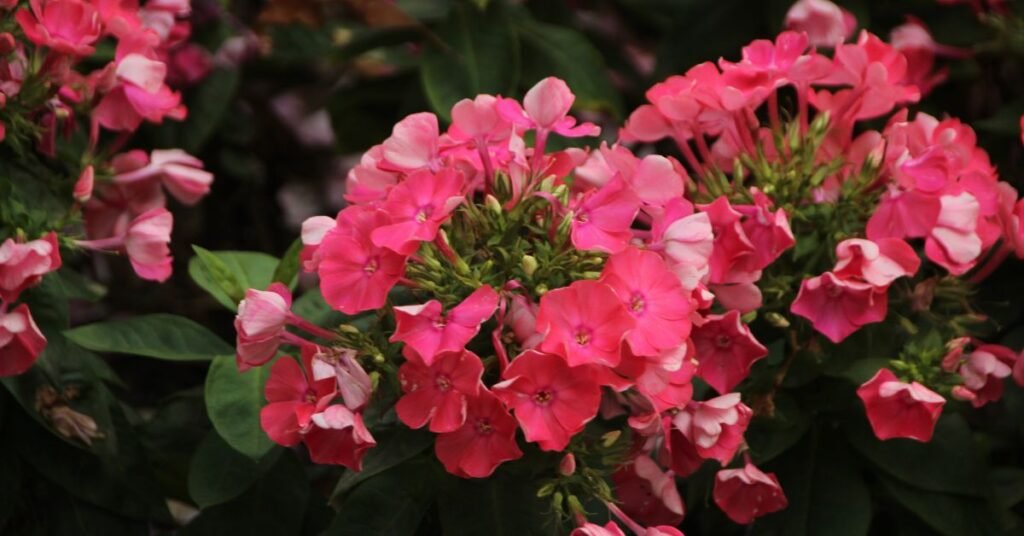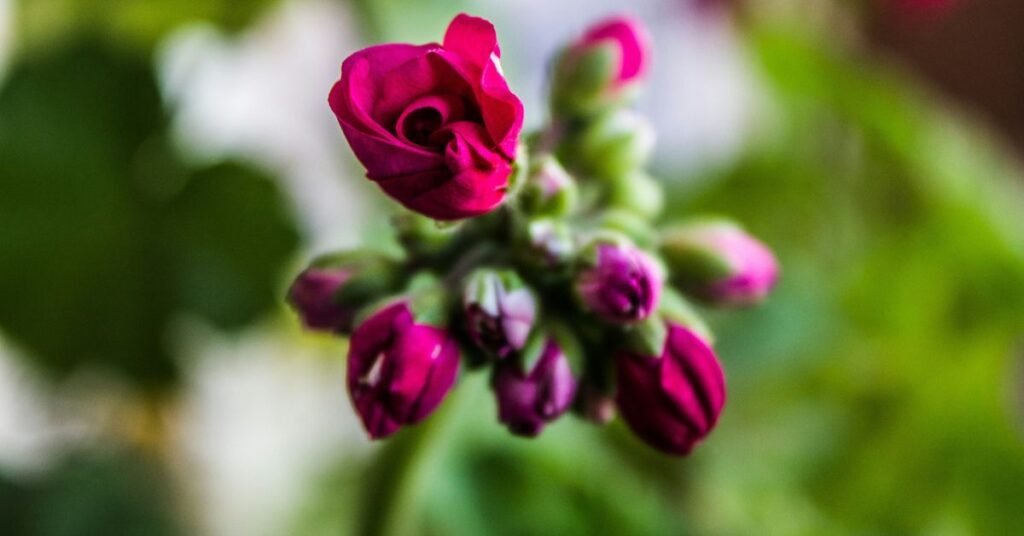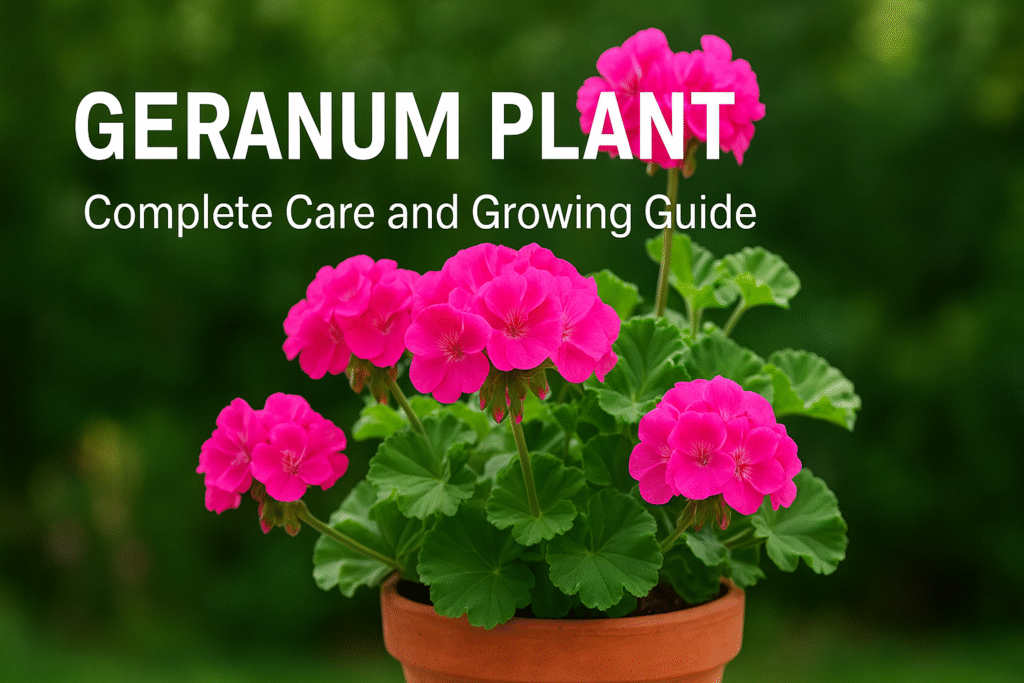Introduction
The Geranium Plant (Pelargonium spp.) is one of the most colorful and popular flowering plants loved by home gardeners worldwide. Known for its bright blooms, pleasant fragrance, and easy maintenance, geraniums are perfect for pots, hanging baskets, and garden beds.
Native to South Africa, this plant thrives in warm, sunny environments and adapts well to indoor as well as outdoor conditions. Its stunning flowers come in shades of pink, red, white, purple, and orange, adding a burst of life to any space.

Types of Geranium Plants
There are several beautiful varieties of geraniums, each with its own charm and growth style.
1. Zonal Geraniums (Pelargonium × hortorum)
These are the most common types found in gardens. They have round, velvety leaves with dark zones and produce clusters of vibrant flowers.
2. Ivy-leaved Geraniums (Pelargonium peltatum)
They have trailing stems and glossy leaves, making them ideal for hanging baskets and window boxes.
3. Regal or Martha Washington Geraniums
Known for their large, showy blooms with ruffled petals. They prefer cooler climates and partial sunlight.
4. Scented-leaved Geraniums
Grown mainly for their aromatic foliage rather than flowers. Leaves emit pleasant fragrances like lemon, rose, mint, or apple when touched.
Ideal Growing Conditions
1. Light
Geraniums love sunlight. They require at least 5–6 hours of direct sunlight daily for abundant flowering. Indoors, place them near a bright window.
2. Soil
Use well-draining soil rich in organic matter. A mix of garden soil, compost, and sand (1:1:1) works perfectly. Poor drainage can cause root rot, so ensure the pot has proper holes.
3. Temperature
Geraniums prefer a temperature range between 18°C and 28°C. Protect them from frost and excessive heat. During winters, move them indoors or cover them at night.
Watering and Humidity
Geranium plants need regular watering but should never sit in soggy soil.
- Water only when the top inch of soil feels dry.
- In summer, increase frequency; in winter, reduce it.
- Avoid watering leaves directly to prevent fungal infections.
- Maintain moderate humidity levels; geraniums dislike excess moisture in the air.
Fertilizing the Geranium Plant
Feed your geraniums every 2–3 weeks during their growing season (spring to summer).
- Use a balanced liquid fertilizer (10-10-10 or 20-20-20) diluted to half strength.
- Stop fertilizing during winter dormancy.
- For organic feeding, compost tea or seaweed extract works beautifully.
Over-fertilizing can cause lush leaves but fewer flowers, so stay moderate.
Pruning and Maintenance
Pruning keeps geranium plants compact, tidy, and full of blooms.
- Regularly remove faded flowers (deadheading) to encourage continuous blooming.
- Trim leggy stems to maintain a bushy appearance.
- Best time to prune is early spring before new growth begins.
- Always use clean scissors or pruning shears to avoid infection.
You can also pinch off the tips of new growth to promote branching.
Propagation Methods
Geraniums are very easy to propagate.
From Cuttings
- Take a 4–6 inch healthy stem cutting below a leaf node.
- Remove lower leaves and dip the base in rooting hormone.
- Plant it in moist potting mix.
- Keep in bright, indirect sunlight until new growth appears (2–3 weeks).
From Seeds
You can also grow geraniums from seeds, though it takes longer.
- Sow seeds in seed trays filled with light soil mix.
- Keep the soil moist and warm.
- Transplant seedlings when they are 3–4 inches tall.
Common Pests and Problems
Like most plants, geraniums can face some pest and disease issues.
Common Pests
- Aphids: Cause curling leaves.
- Whiteflies: Lead to sticky residue on foliage.
- Spider Mites: Create fine webs and yellow spots.
Solution: Spray neem oil or a mild soap solution once every two weeks.
Common Diseases
- Root Rot: From overwatering; use well-draining soil.
- Botrytis Blight: Gray mold on flowers; remove infected parts.
- Rust or Leaf Spots: Caused by high humidity; ensure good air circulation.
Flowering and Care During Bloom

Geraniums bloom best during spring and summer. To ensure long-lasting flowers:
- Provide full sunlight and regular feeding.
- Deadhead old blooms regularly.
- Avoid overwatering during blooming phase.
- Rotate pots weekly for even growth.
After flowering, prune lightly and reduce watering to help the plant rest before the next blooming cycle.
Indoor vs. Outdoor Geranium Care
| Feature | Indoor Geranium | Outdoor Geranium |
|---|---|---|
| Light | Bright window light | Full sunlight |
| Watering | Moderate | Frequent (depending on heat) |
| Temperature | 18–25°C | 20–30°C |
| Maintenance | Low | Moderate |
| Blooming | Seasonal | Continuous in warm weather |
Both types add charm, but outdoor geraniums usually bloom more profusely.
Geranium Uses and Benefits
- Decorative: Adds beauty to balconies, gardens, and windowsills.
- Medicinal: Geranium essential oil helps reduce stress and improves skin tone.
- Aromatic: Scented varieties are used in perfumes and potpourri.
- Pollinator-Friendly: Attracts bees and butterflies to your garden.
Conclusion
The Geranium Plant is a perfect choice for those who love vibrant color, fragrance, and low-maintenance gardening. With minimal effort and care, it rewards you with continuous blooms and a cheerful garden atmosphere.
Just remember to give it plenty of sunlight, avoid overwatering, and prune regularly — and your geraniums will flourish beautifully all year long.

